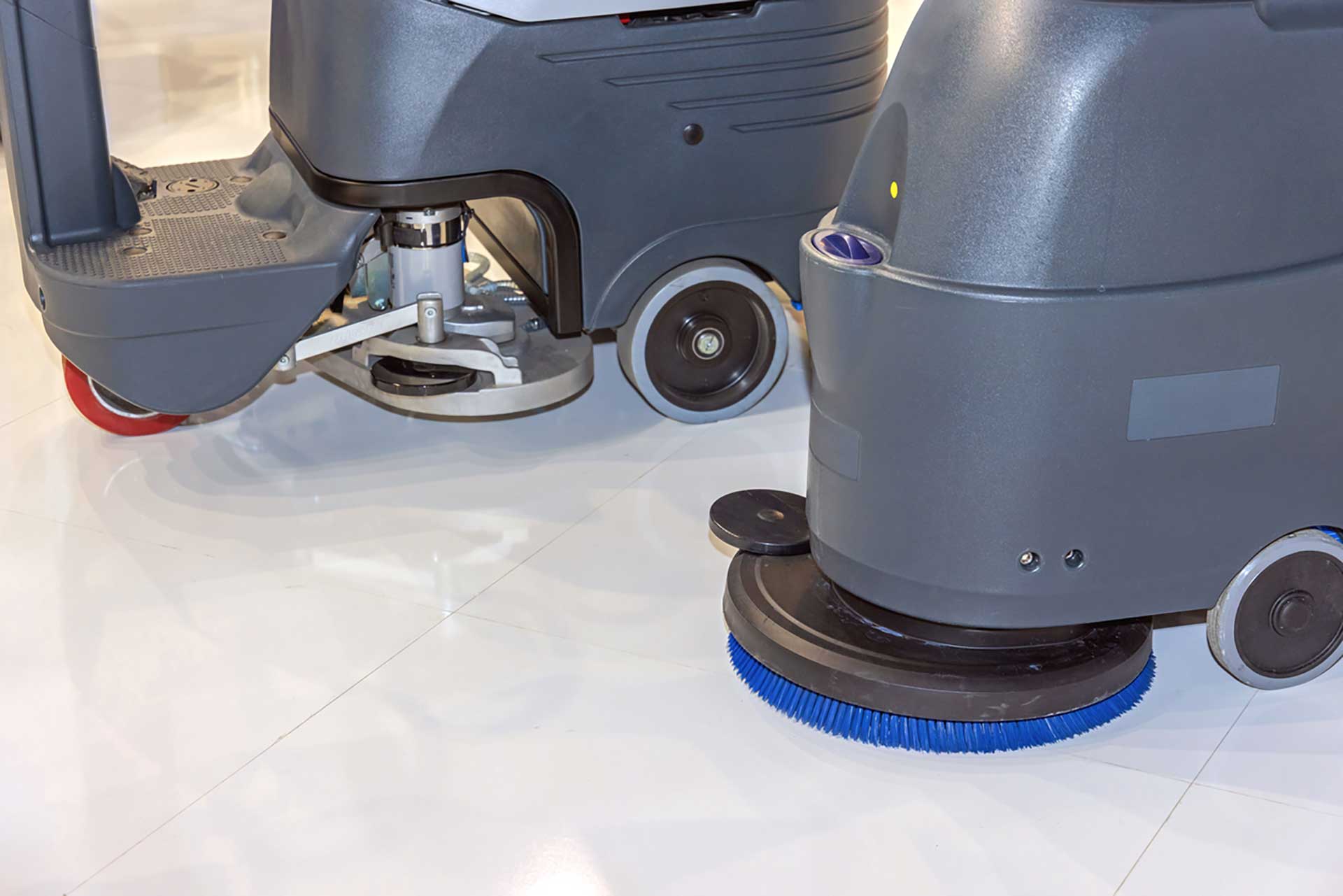Imagine your commercial space gleaming from corner to corner, the floors pristine—a testament to efficiency. You’re keen on maintaining this without breaking the bank. That’s where understanding the costs of commercial floor cleaning machines becomes vital. From the humming scrubbers to the whirring sweepers, we’ll guide you through prices, maintenance, and financing options. You’ll navigate the nuances of investing in the right equipment with the savvy of an industry pro. Let’s dive in.
Types of Industrial Floor Cleaners
You’ll find that the main types of industrial floor cleaners include scrubbers, sweepers, and vacuum cleaners, each varying in function and cost. When you’re selecting equipment for maintaining large floor areas, machine efficiency and cleaning versatility are critical factors to consider.
Industrial scrubbers are ideal for deep cleaning and sanitizing. They use a system of brushes or pads combined with a cleaning solution to remove dirt, spills, and stains from hard floors. The efficiency of these machines lies in their ability to clean large spaces rapidly, often with minimal water waste due to advanced recovery systems.
Sweepers are your go-to machines for removing debris and dust. They come in various sizes, from walk-behind models to ride-on units, designed to tackle different scales of operation. Their efficiency is showcased in their sweeping mechanisms, which can cover extensive areas quickly, saving you time and labor costs.
Vacuum cleaners designed for industrial use are robust and can handle a wide range of debris types. They boast high filtration systems and large-capacity containers to maintain efficiency over prolonged use. The versatility of these vacuums allows for cleaning across multiple surfaces, from carpets to warehouse floors, ensuring a comprehensive cleaning solution.
Price Ranges for Scrubbers
Commercial scrubbers vary in price from around $1,000 for basic models to over $20,000 for high-end, ride-on machines. The range reflects the diversity in scrubber efficiency and features tailored to different commercial cleaning needs. As you assess your options, consider not just the upfront cost but also the long-term value, factoring in the machine’s efficiency and its environmental impact.
When evaluating scrubbers, pay attention to:
- Cleaning Path Width: Wider paths cover more area, reducing labor time.
- Solution Tank Capacity: Larger tanks mean fewer refills, increasing productivity.
- Battery Life: Longer life equals less downtime, boosting efficiency.
- Squeegee System: A superior squeegee system ensures drier floors, reducing slip hazards.
- Eco-Friendly Options: Machines with reduced water and chemical usage lower environmental impact.
Remember that the initial investment in a commercial scrubber can be offset by the savings in labor and maintenance costs. High-efficiency scrubbers may have a higher price tag but can lead to significant cost savings over time. Additionally, choosing machines with a lower environmental impact can contribute to sustainability goals and potentially qualify for green certifications, enhancing your company’s image.
Cost Analysis of Sweepers
As you examine the costs associated with commercial sweepers, it’s important to understand that prices can range significantly based on size, functionality, and additional features. Entry-level walk-behind models may start at a few thousand dollars, while high-end, ride-on sweepers can approach or exceed the cost of a new vehicle, depending on their capabilities.
When considering the investment, sweeper longevity and operational efficiency are crucial factors. A well-built, durable sweeper may command a higher upfront cost but can offer a lower total cost of ownership over its lifespan. The efficiency of operation should also be a primary consideration. Machines that cover larger areas in less time and with less energy consumption provide greater value by reducing labor costs and minimizing downtime.
It’s advisable to compare the lifespan of different models, warranty offerings, and the availability of replacement parts. A sweeper with a robust support network and accessible service can mitigate long-term costs associated with maintenance and repairs. Furthermore, consider the machine’s adaptability to different environments. Sweeper versatility can be a valuable asset that enhances its cost-effectiveness across various applications. Therefore, a comprehensive cost analysis should extend beyond the purchase price to encompass the sweeper’s performance and sustainability in your specific operational context.
Maintenance and Repair Expenses
In addition to the initial purchase price, you’re likely to encounter ongoing maintenance and repair expenses over the lifespan of your floor cleaning machine. These costs can accumulate and impact your budget if not managed wisely.
Proactive maintenance is crucial to minimize unexpected breakdowns which can be costly and disruptive to your operations. Scheduled servicing, consistent cleaning, and proper operation are key in extending the life of your equipment. Here are some technical aspects you should consider to manage maintenance and repair expenses effectively:
- Regularly replace wear-and-tear items like brushes and filters to prevent larger issues.
- Ensure that batteries are properly maintained to extend their lifespan.
- Train your staff on the correct use of the machines to avoid operator error.
- Keep an eye on the warranty period and consider warranty extensions for critical components.
- Plan for a maintenance fund to address unexpected breakdowns without financial strain.
Financing and Leasing Options
You’ll find that financing or leasing your floor cleaning machine can offer a more manageable payment structure than outright purchase. Leasing benefits include lower upfront costs and the ability to upgrade equipment more frequently, keeping pace with the latest technology. This option often includes maintenance services, reducing the worry about potential repair costs down the line.
With leasing, you also preserve capital and improve cash flow, which can be critical for maintaining business operations. It’s a strategic choice that aligns with effective budget management and financial planning. However, it’s essential to understand the terms of the lease agreement, including the length of the lease and the end-of-term options.
On the other hand, financing drawbacks must be considered. While financing allows you to eventually own the equipment, it also means incurring interest over time, which adds to the total cost. You’re responsible for maintenance and repairs, which can be unpredictable expenses. Additionally, as the owner of the machine, you may face obsolescence risks as new, more efficient models become available.
Carefully weigh the pros and cons of each option, considering your company’s financial health, long-term plans, and the specific needs of your operations before making a decision.
Frequently Asked Questions
How Does the Size and Layout of My Facility Impact the Choice of a Commercial Floor Cleaning Machine?
The size and layout of your facility directly influence your choice of a commercial floor cleaning machine. Larger spaces may require machines with greater cleaning efficiency to cover vast areas quickly, while complex layouts might need smaller, more maneuverable equipment. It’s crucial to balance these factors to minimize maintenance costs, ensuring you’re investing in a machine that not only fits the physical environment but also optimizes your cleaning operations and budget over time.
Are There Any Environmental or Sustainability Factors to Consider When Selecting a Commercial Floor Cleaning Machine?
Yes, when selecting a commercial floor cleaning machine, you should consider environmental factors. Look for models that work efficiently with eco-friendly detergents, reducing harmful chemical use. Also, prioritize machines that promote water conservation, as they’ll not only save resources but also reduce your utility costs over time. Opting for such sustainable features demonstrates your commitment to environmental responsibility and can positively impact your facility’s operation and maintenance practices.
How Do Training and Operator Skill Levels Affect the Efficiency and Cost-Effectiveness of Using Floor Cleaning Machines?
Training and operator skill levels directly impact operator efficiency with floor cleaning machines. You’ll see better results and cost-effectiveness when you invest in thorough training. Skilled operators use machines more effectively, minimizing waste and reducing wear and tear. Your training investment pays off by extending the lifespan of equipment and ensuring that cleaning tasks are completed with greater precision, ultimately saving you money and improving your facility’s cleanliness.
What Are the Safety Features to Look for in Commercial Floor Cleaning Machines to Ensure Operator and Workplace Safety?
When choosing commercial floor cleaning machines, you should prioritize safety features. Ensure the model has excellent operator ergonomics to prevent strain during use, and always check for a reliable emergency stop function to quickly halt operation in case of danger. These features are crucial for maintaining a safe working environment and minimizing the risk of accidents, which can have costly and harmful consequences. Stay vigilant about these aspects to protect yourself and your workplace.
Can Commercial Floor Cleaning Machines Be Customized to Meet Specific Needs of My Business, and How Does Customization Impact Cost?
You can tailor commercial floor cleaners to your business’s unique landscape, but remember, machine customization factors into your budget as a cost variable. As you enhance safety features or performance specs, the price tag gently climbs. It’s a dance of give-and-take; prioritize your needs, and the cost adjusts accordingly. Trust that every added feature is an investment in operational harmony, ensuring the machine works as an extension of your team’s efforts.






Comments are closed